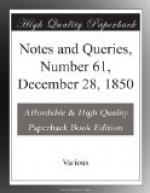* * * * *
The Dewerstone is a lofty mass of rock rising above the bed of the Plym, on the southern edge of Dartmoor. During a deep snow, the traces of a naked human foot and of a cloven hoof were found ascending to the highest point. The valley below is haunted by a black headless dog. Query, is it Dewerstone, Tiwes-tun, or Tiwes-stan?—(Kemble’s Saxons, vol. i. p. 351.)
* * * * *
The great Cromlech at Drewsteignton is said to have been erected by three spinsters (meaning spinners); another legend says by three young men. The first is the more usual saying. The Cromlech is generally called “The Spinster’s Rock.” Rowe (Dartmoor, p. 99.) suggests that the three spinsters were the Valkyrien, or perhaps the Fates. He is no doubt right.
* * * * *
Rock and stone legends abound. A great quoit on the top of Heltor is said to have been thrown {513} there by the Devil during fight with King Arthur. Adin’s Hole (Etin’s) is the name of a sea cavern near Torquay; another is Daddy’s Hole. The Devil long hindered the building of Buckfastleigh Church, which stands on the top of a steep hill. A stone, at about the distance of a mile, has the marks of his finger and thumb. The stone circles, &c. on Dartmoor, are said to have been made “when there were wolves on the hills, and winged serpents in the low lands.” On the side of Belstone Tor, near Oakhampton, is a small grave circle called “Nine Stones.” It is said to dance every day at noon.
* * * * *
Whoever shall find the treasure hidden in Ringmore Down, may plough with a golden plough-share, and yoke his oxen with golden cross-sticks.
R.J.K.
A CHRISTMAS CAROL.
The following carol has not, I believe, been printed in any of the modern collections; certainly it is not in those of Mr. Sandys and Mr. Wright. It is copied from Ad. MS. Brit. Mus. 15,225, a manuscript of the time of James I. It may, perhaps, bethought appropriate for insertion in your Christmas number. I have modernised the orthography.
A CAROL FOR CHRISTMAS-DAY.




